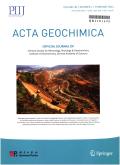摘要
江朗穹窿具有完整的构造地层单元,含一套高品位层状铜矿床。然而,该穹窿的形成机制和铜成矿的成因模式仍存在争议。这些问题的解决取决于岩心中是否存在岩浆侵入。本文报道了新发现正长岩侵入体的大量地球化学和锆石U-Pb数据,以及黄铜矿Re-Os测年结果。探讨江朗穹窿成因、层状铜矿床成因模式及正长岩侵入体稀有金属成矿潜力。正长岩年龄为207.1±2.0 Ma,与松潘-甘泽造山带碰撞后伸展相吻合。正长岩的平均高(Zr + Nb + Ce + Y)浓度为512 ppm, 10000×Ga/Al比值为3.97,结晶温度为827℃,低Mg#值为1.73;它们符合a型花岗岩定义和地壳成因。黄铜矿分离物的Re-Os等时线年龄为207.1±5.3 Ma,明显晚于其含矿岩(Liwu Group,约553 Ma)的形成年龄。新的年龄测定,结合已有的151.1 Ma左右的黄铜矿Re-Os等时线年龄、硫化物硫同位素(δ34SV-CDT = 8.7‰~ 5.6‰)和电气石硼同位素(δ11B = - 15.47‰~ - 5.91‰)数据,证实了与岩浆-热液流体有关的多期后生铜成矿作用。与区域约209 ~ 207 Ma富质花岗岩类相比,正长岩体显示出未演化的贫瘠亲和关系,稀有金属成矿潜力可忽略不计。结合江朗穹窿岩心残余重力低异常,表明存在大型深部花岗质基底,认为该穹窿的性质为岩浆隆升所致的热穹窿。The Jianglang Dome has integral tectonostratigraphic units and contains a suite of high-grade stratiform Cu deposits. However, the formation mechanism of this dome and genetic model of Cu mineralization remain a matter of debate. The resolution of these problems hinges on the presence of magmatic intrusions in the core. Here, we report bulk geochemical and zircon U-Pb data of a newly discovered syenite intrusion as well as chalcopyrite Re-Os dating results. We aim to explore genesis of the Jianglang Dome, genetic model of the stratiform Cu deposits, and rare metal mineralization potential of the syenite intrusion. The dated syenite sample yields an emplacement age of 207.1 ± 2.0 Ma, which matches post-collisional extension in the Songpan-Ganze Orogen. The syenite rocks have average high (Zr + Nb + Ce + Y) concentrations of 512 ppm, 10000×Ga/Al ratios of 3.97, and crystallization temperatures of 827 °C, together with low Mg# values of 1.73; they fit the A-type granitoid definition and a crustal origin. Chalcopyrite separates yield a Re-Os isochron age of 207.1 ± 5.3 Ma, which markedly postdates the formation age of their ore-hosting rocks (the Liwu Group, ca. 553 Ma). Our new age determination, together with previous chalcopyrite Re–Os isochron age of ca. 151.1 Ma and sulfide sulfur isotope (δ34SV-CDT = 8.7‰–5.6‰) and tourmaline boron isotope (δ11B = − 15.47‰ to − 5.91‰) data, confirms multistage epigenetic Cu mineralization related to magmatic-hydrothermal fluids. Compared with regional ca. 209–207 Ma fertile granitoids, the studied syenite intrusion shows unevolved and barren affinities and negligible rare metal mineralization potential. Combined with residual gravity low anomalies in the core of the Jianglang Dome, which suggest a large deep-seated granitic batholith, we prefer thermal doming resulting from magma-induced uplift for the nature of this dome.

 求助内容:
求助内容: 应助结果提醒方式:
应助结果提醒方式:


